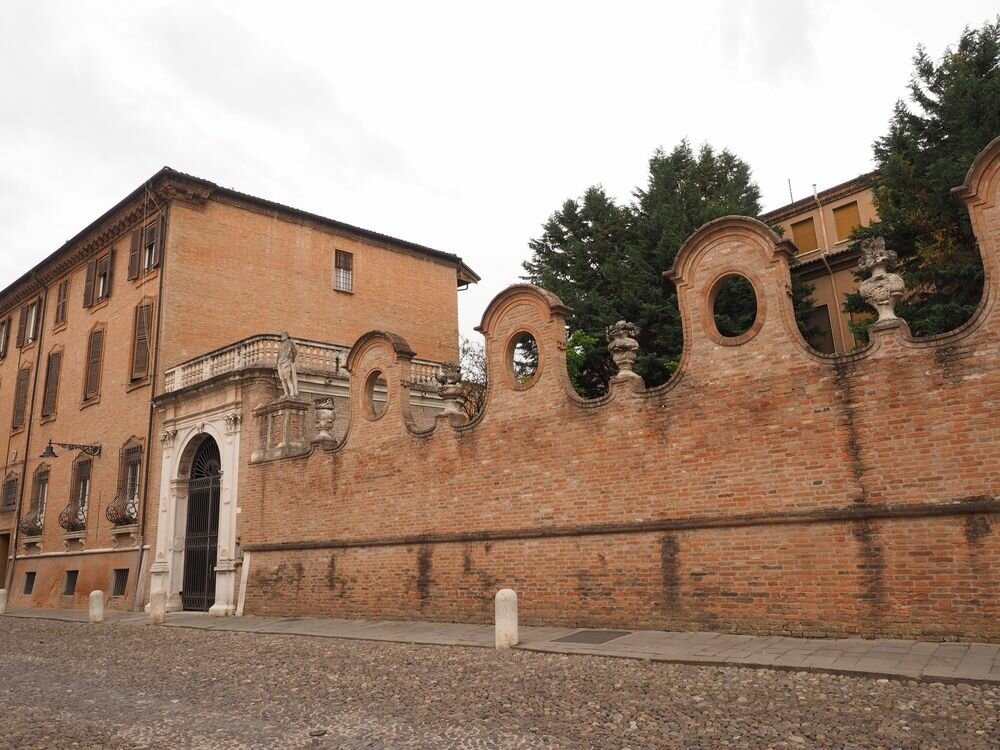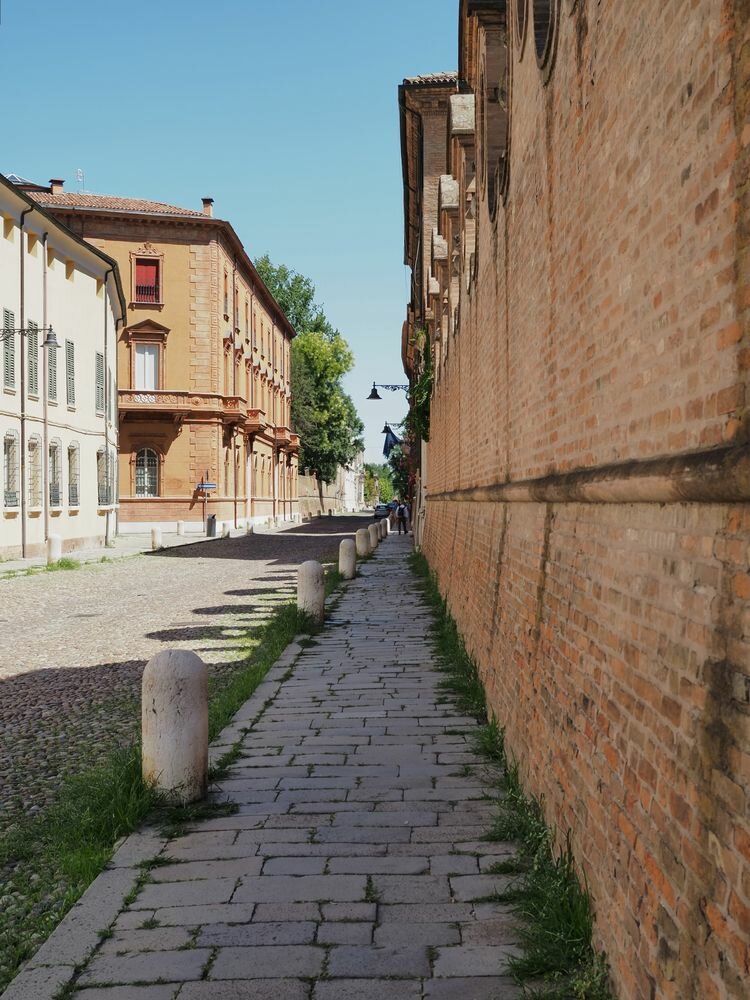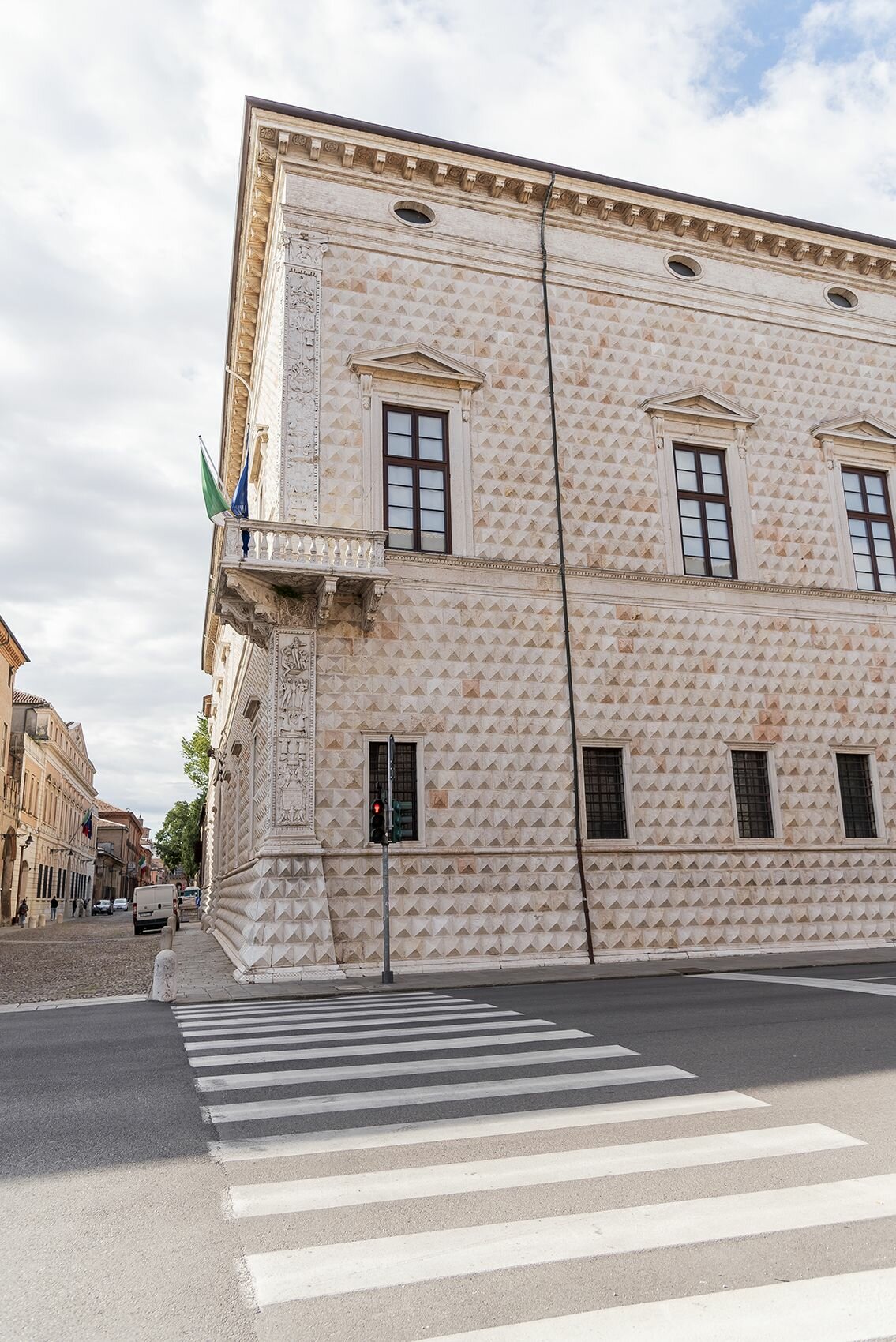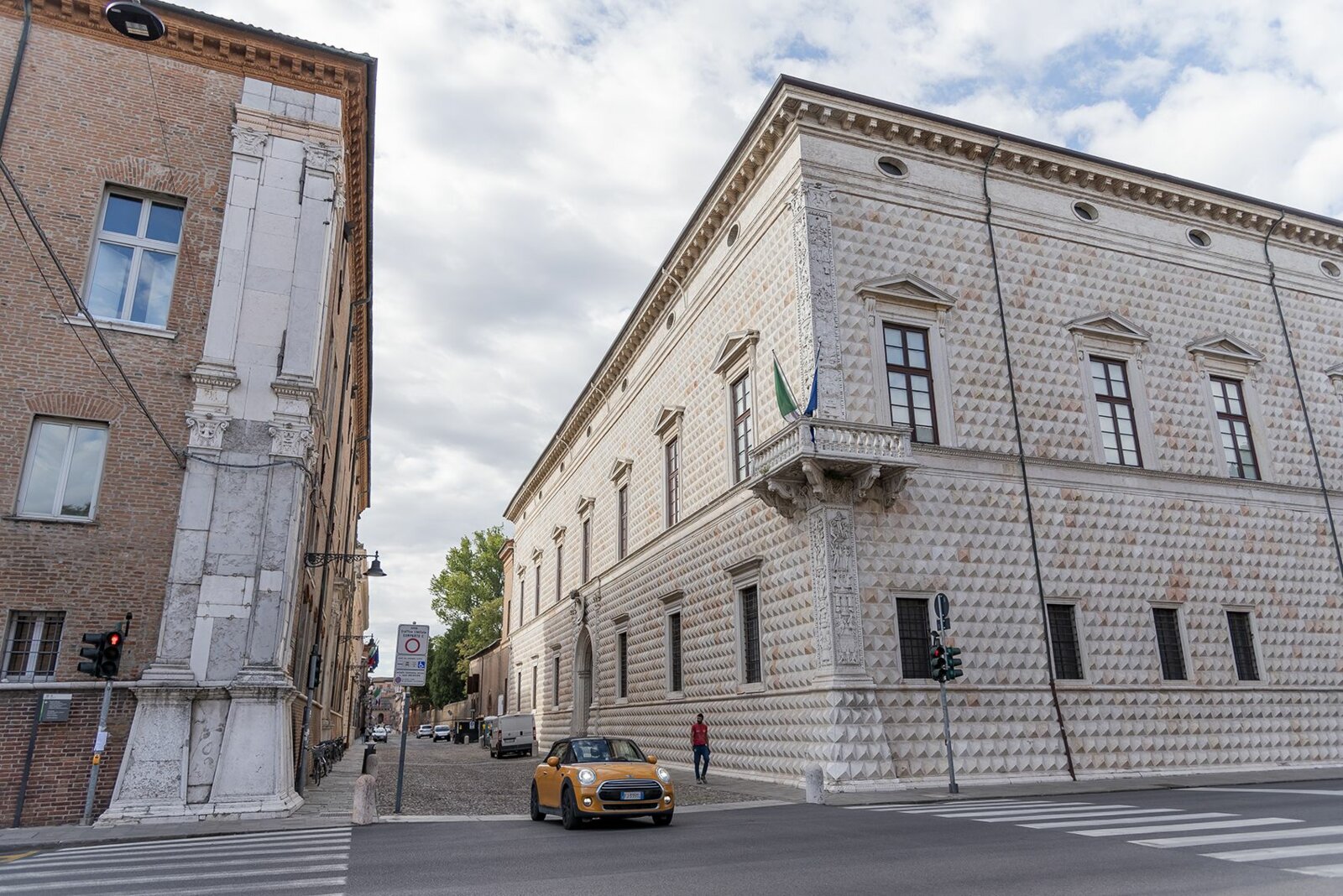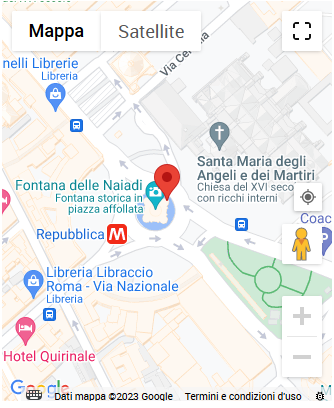Potrebbe interessarti anche

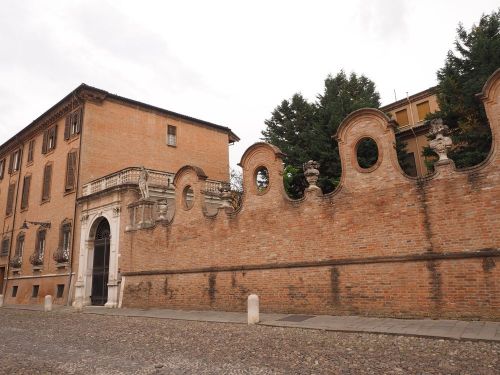
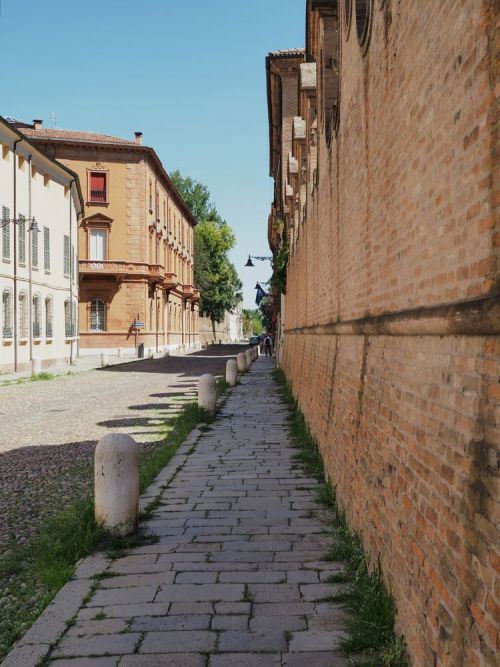
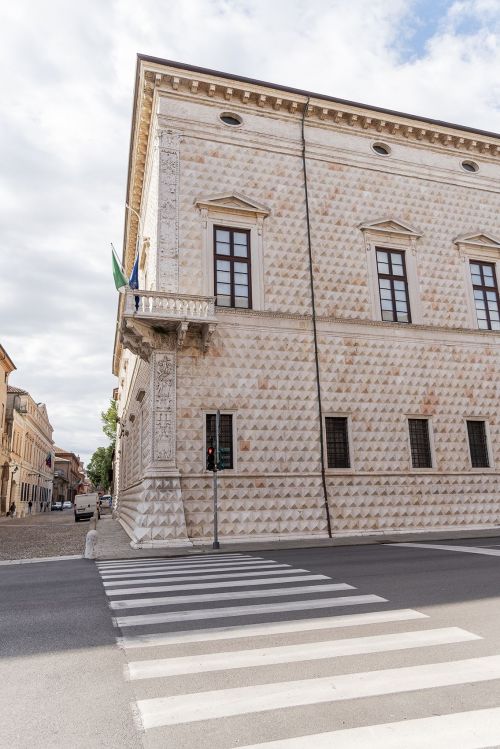
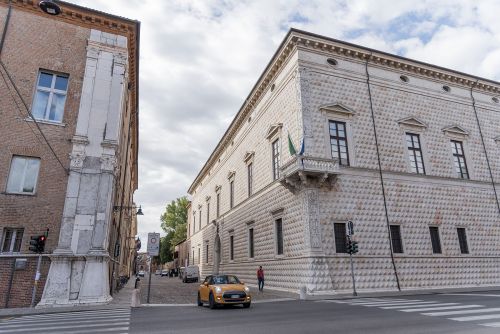
Corso Ercole I d'Este and The Quadrivio degli Angeli
Corso Ercole I d'Este is definitely one of the most beautiful historical avenues in Europe, and is certainly one of the most photographed places in Ferrara.
With its palaces and fascinating views, it will leave you speechless, and you will find that you will not know where to look in order not to miss any detail.
A long street joining the Estense Castle to city walls, more precisely to the Porta degli Angeli, crossing one of the city's most famous crossroads, the Quadrivio degli Angeli.
Historical Notes
Where Corso Ercole I d'Este meets Via Biagio Rossetti - between the magnificent Palazzo dei Diamanti, Palazzo Prosperi Sacrati, Palazzo Pallavicini and Palazzo Turchi di Bagno - you can find the heart of the so called Addizione Erculea. This innovative project of enlargement of the walled city developed by the architect Biagio Rossetti, is one of the main motivation of is one of the main reasons for Ferrara's inclusion in the UNESCO World Heritage List as "Ferrara, city of Renaissance".
The architect decided to assign each building a different and precise 'architectural weight', thus making each building stand out with its specific characteristics.
Palazzo dei Diamanti
More than 8500 diamond-pointed blocks of white and pink marble characterize, in name and in fact, the well-known Palazzo dei Diamanti. Designed by renowned architect Biagio Rossetti, it was built on commission by Sigismondo d'Este. With its snow-white tips, it is undoubtedly the building that stands out most among those facing the crossroads.Today, the inside of the palace is an art exhibition space. While the ground floor hosts Ferrara Arte modern and contemporary art exhibitions, the main floor is occupied by the National Picture Gallery.
Palazzo Prosperi Sacrati
Palazzo Prosperi-Sacrati is the oldest building of the Addizione Erculea. Begun in 1493, its foundations dictated the direction of the Addizione Erculea's main axes.
Ercole I d'Este commissioned the palace for his personal physician, Francesco da Castello. From era to era, Palazzo Prosperi Sacrati became home to several noble families of Ferrara. The palace belongs to the Municipality of Ferrara since 1997 when it was sold by the Ministry of Defense following a trade.
The space that was once occupied by the palace gardens, with its vegetable gardens, is now the Educational Laboratory of Archaeology of the L. Ariosto Classical High School.
Palazzo Turchi di Bagno
On another corner of the Quadrivio, in front of the Palazzo dei Diamanti, we find Palazzo Turchi di Bagno, now belonging to the university and museum exhibition space. The palace was built in 1498 under the direct supervision of Duke Ercole I d'Este. The first buyer of the building was Aldobrandino Turchi, a Ferrara patrician belonging to the same family which central Via del Turco is also named after.
After being owned for some time by the Bagno family, the palace was transferred to military state property in 1933 having been heavily damaged by bombing during World War II. Since 1962, the Botanical Garden of Ferrara can be visited in the garden of the Palace. The palace is often a venue for exhibitions and initiatives of the university museum system.
Palazzo Bevilacqua (Pallavicini)
Palazzo Bevilaqua, known as the “Quartierone”, was built in the late 15th century by will of Bonifacio Bevilacqua, a courtier of the Este family. It has been then purchased by Alfonso I d’Este in 1530.
In 1763 it was purchased by the imperial marshal Luca Pallavicini, but his renovation project was never competed. From 1796 to the present day, the building retains its military function as barrack, now hosting the Police.
Despite its evolutions, the palace still retains 17th-century features, though the Renaissance ones are now unfortunately hidden.
You may not know about...
THE PALACES OF CORSO ERCOLE I D'ESTE. In addition to those that make up the Quadrivio degli Angeli, Corso Ercole I d'Este is studded with splendid Renaissance palaces, now used as institutional, university or private headquarters. Opposite the Estense Castle you will find the former Stock Exchange building and former Monte di Pietà, now used as a meeting place and office building, and the Ferrara Chamber of Commerce building. Going on, you can also admire Palazzo Gulinelli, seat of an international school, Palazzo Scola-Camerini, seat of the Questura, Palazzo Giulio d'Este, seat of the Prefecture, and Palazzo Trotti-Mosti, seat of the Faculty of Law of the University of Ferrara.
THE MEMORIES OF ANTONIO FRIZZI. Antonio Frizzi, in his volume Memorie per la Storia di Ferrara of 1809, describes the project of the Addizione Erculea: "It seemed to Hercules that the city of Ferrara was cramped in proportion to its population at the time, even though it had diminished so much in past misfortunes, and he imagined that it should increase in the future... Hercules, therefore, made the great resolution to enlarge the city to more than double its size... Observing that the Prince's palace, the Cathedral, and the greater square stood there at one end near the walls and ditches and that the plan of the city was very extensive from East to West, but too narrow from Midday to North, on this side he divided to enlarge its boundaries... Biagio Rossetti, an architect from Ferrara, if we are staying with Guarini, was the director of the work… It was therefore begun in the year 1492 on the 29th of August a very wide ditch, which departs from the side of S. Marco to the West..., and embracing within a great circle of about 3 miles to the North the Churches of S. Gabriele, S. Barnaba, S.M. degli Angeli... ended to the East at the Canto del Follo, and at the Canal Naviglio now called di Baura...The space enclosed by the new walls was called Terranuova and also Addizione Erculea by its author."

